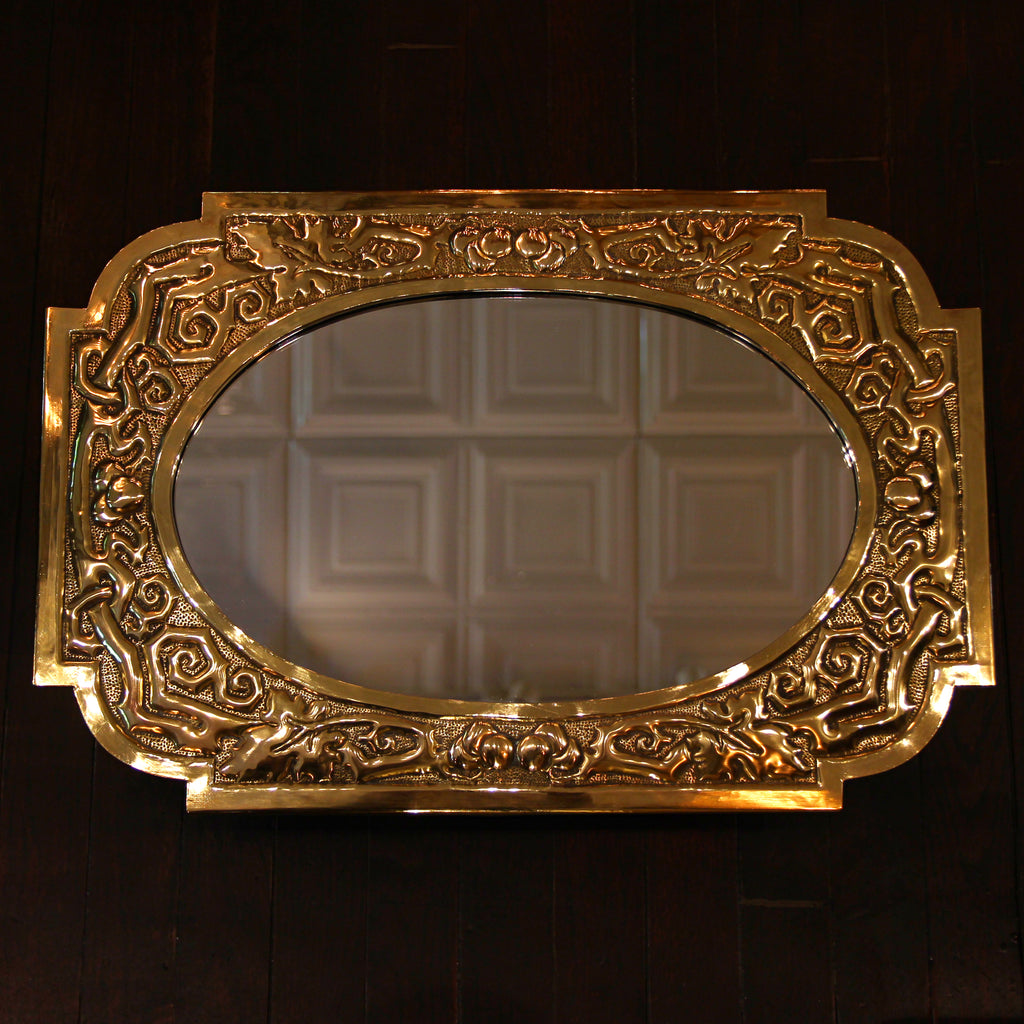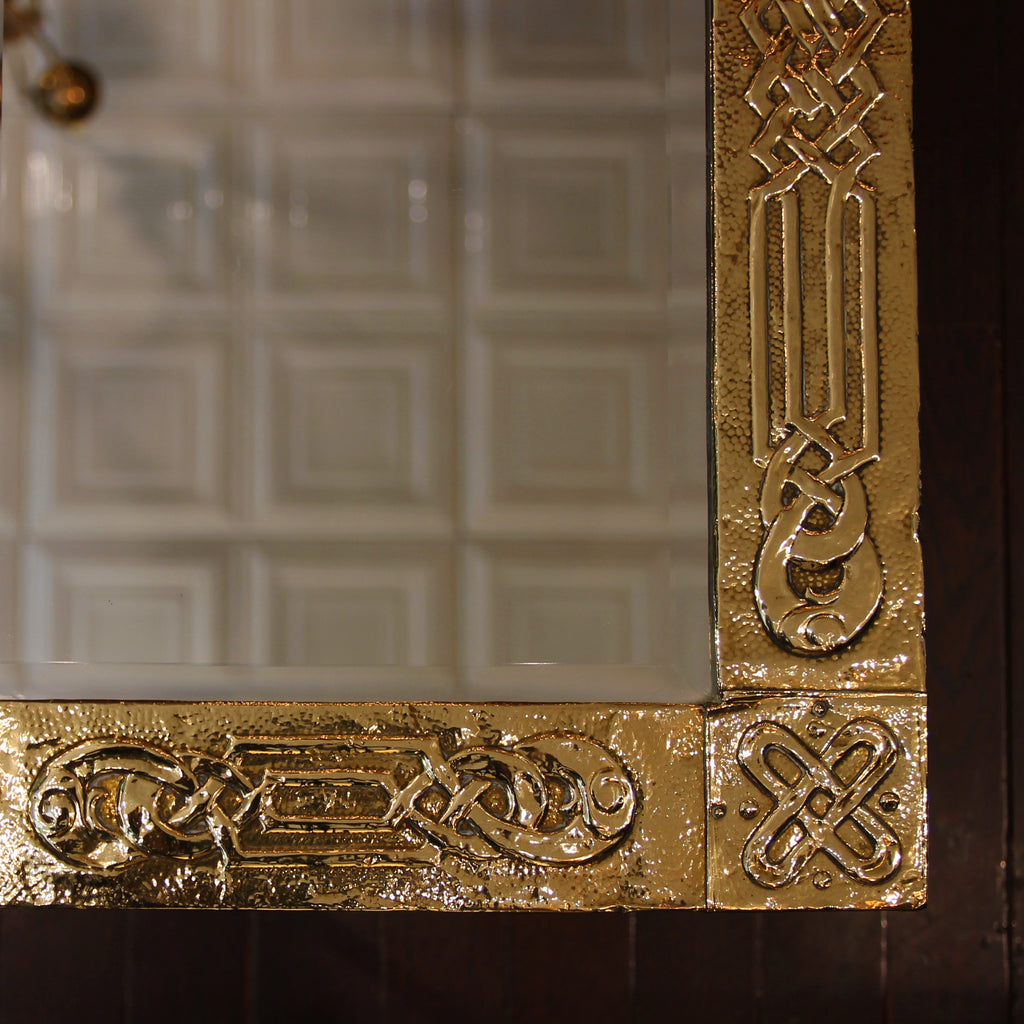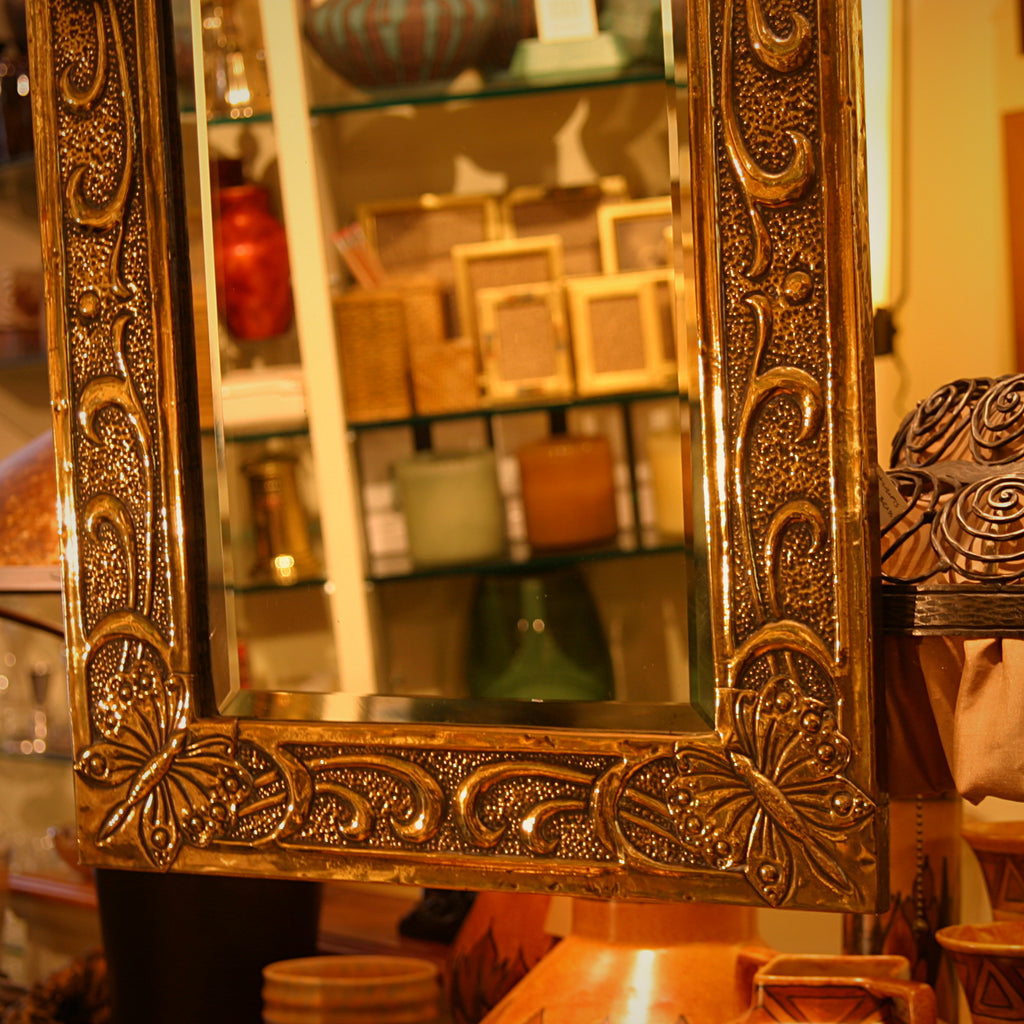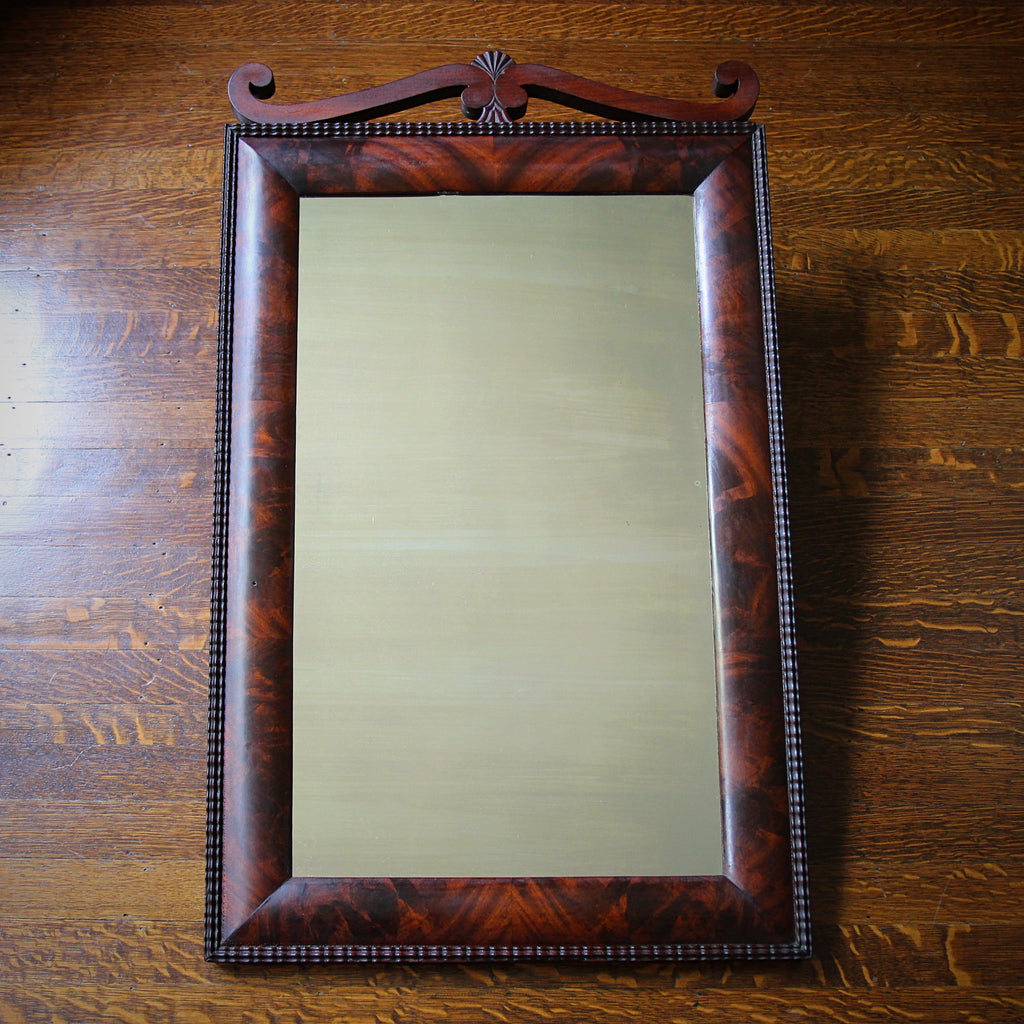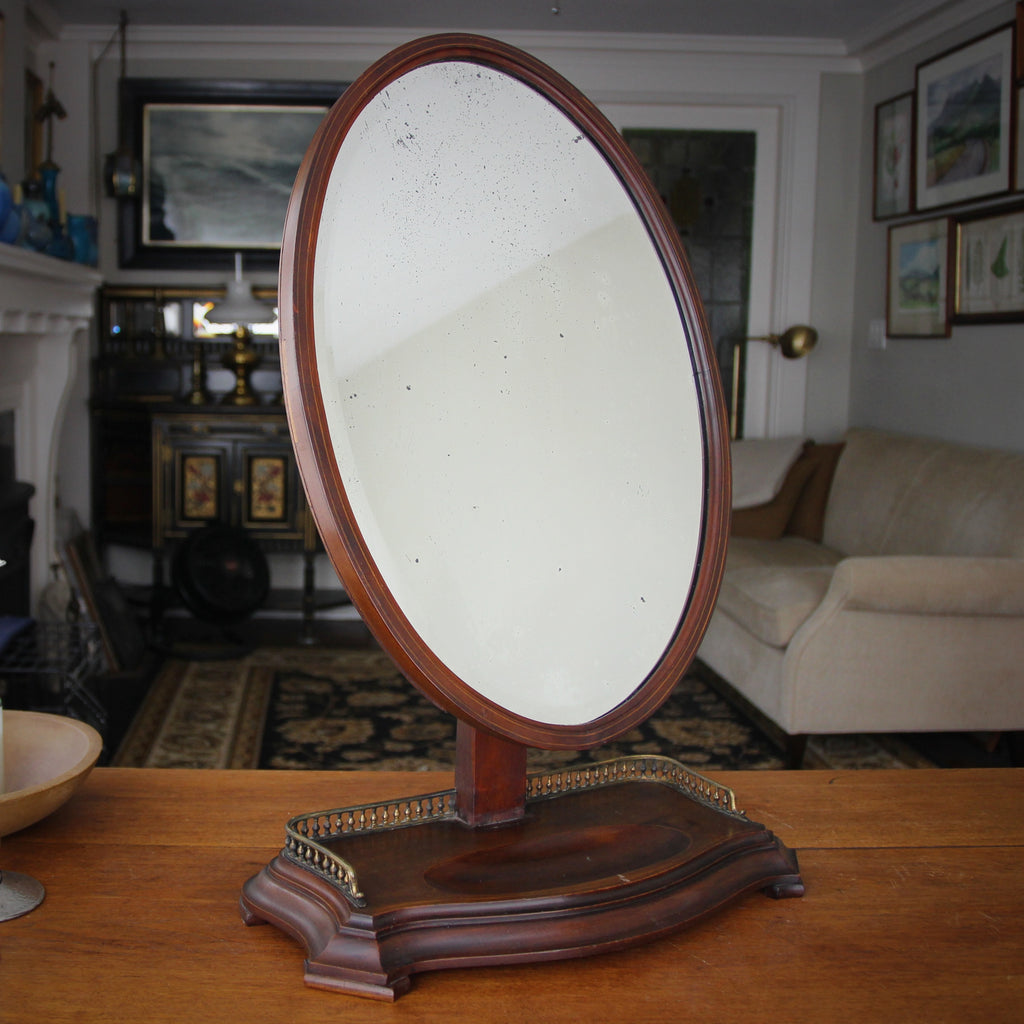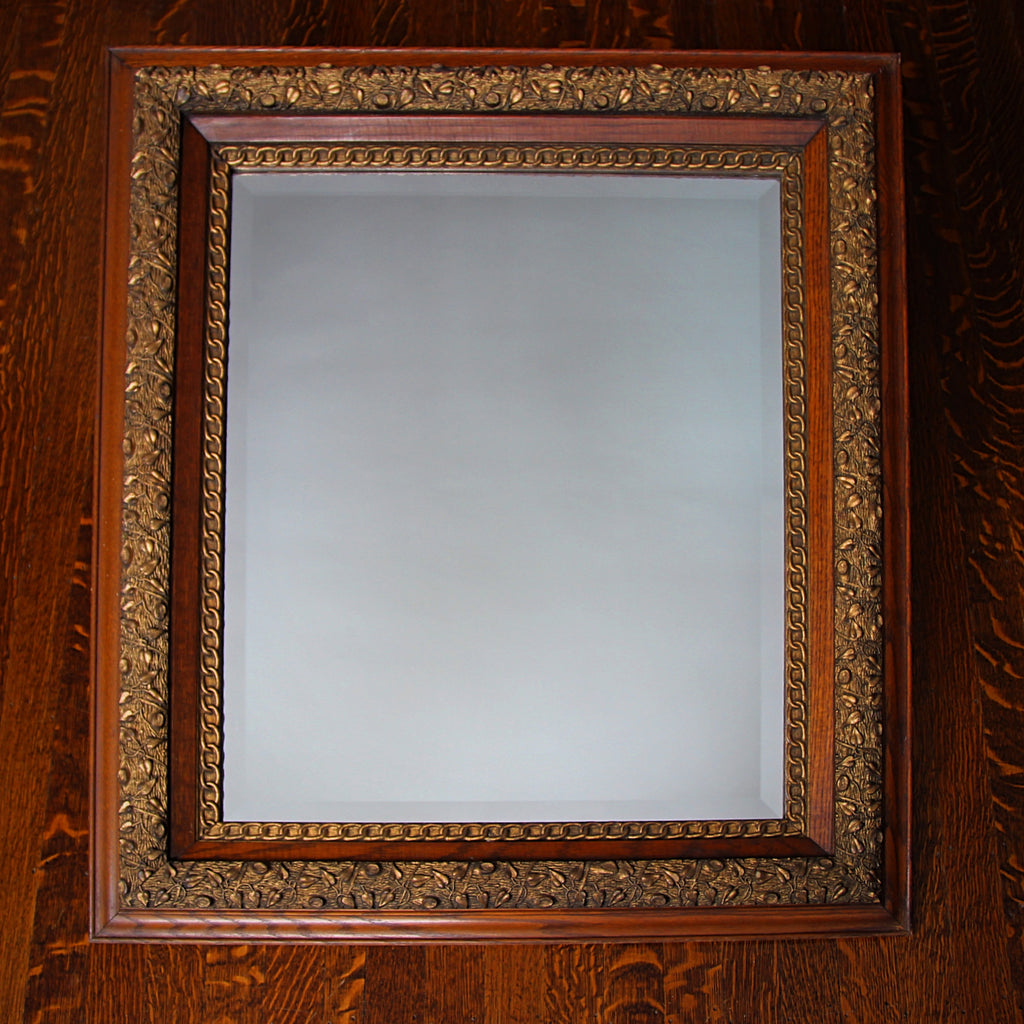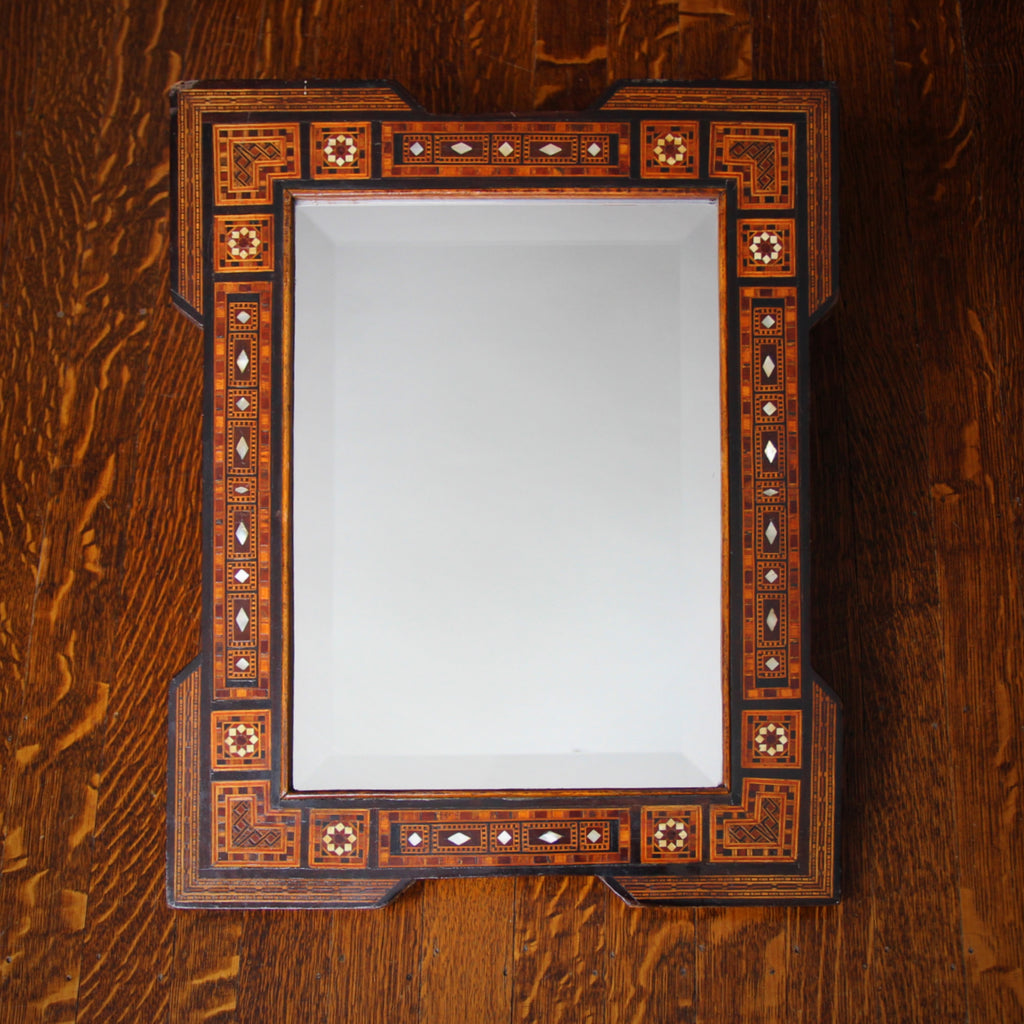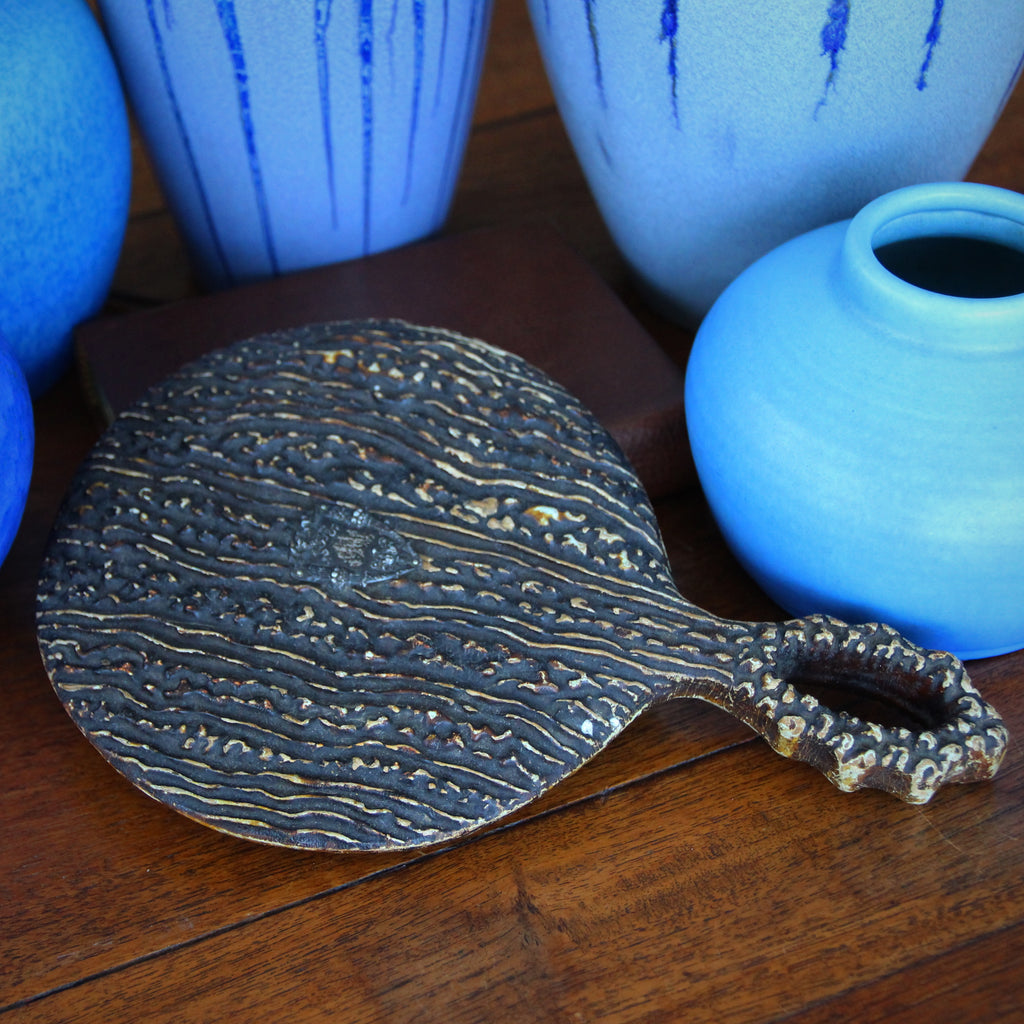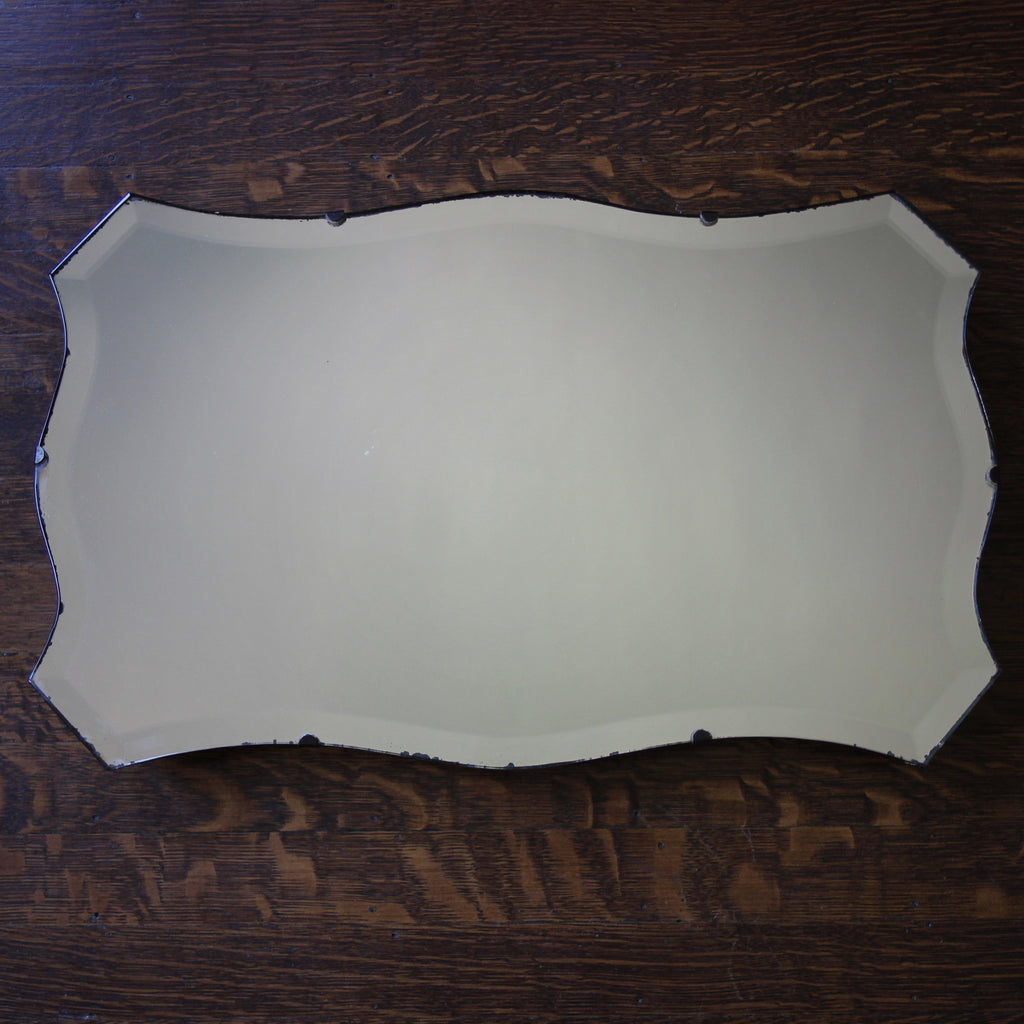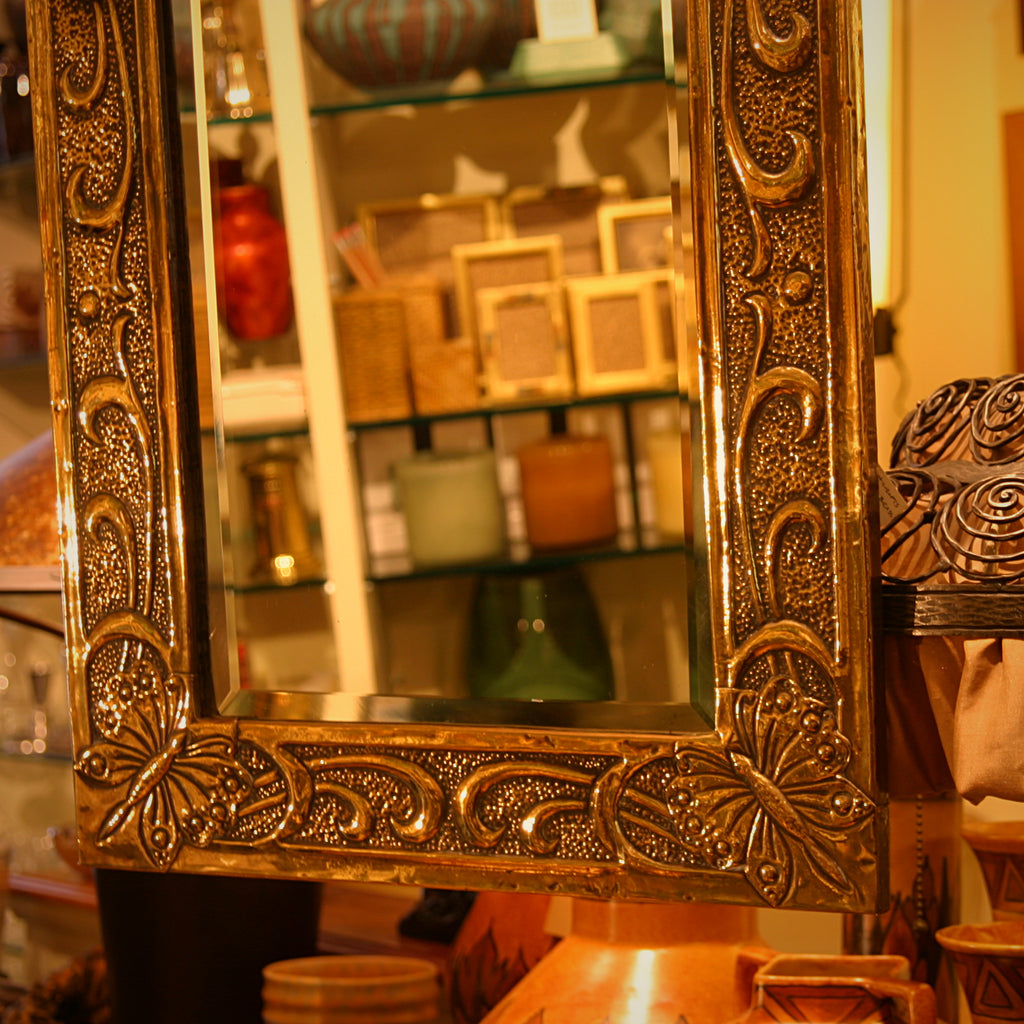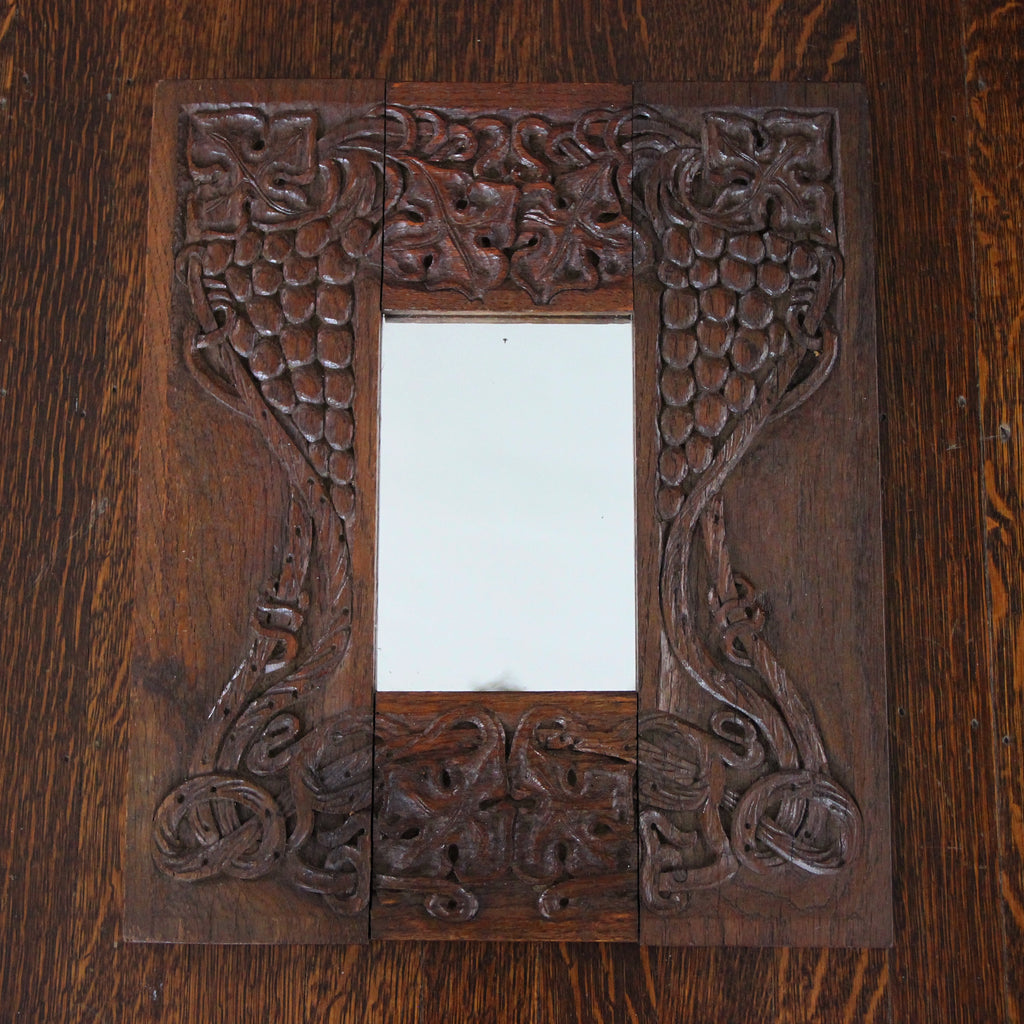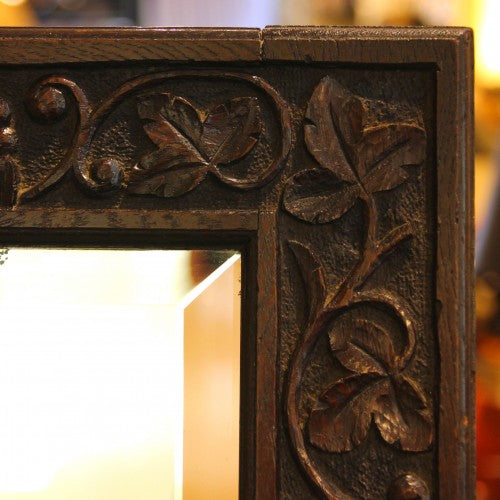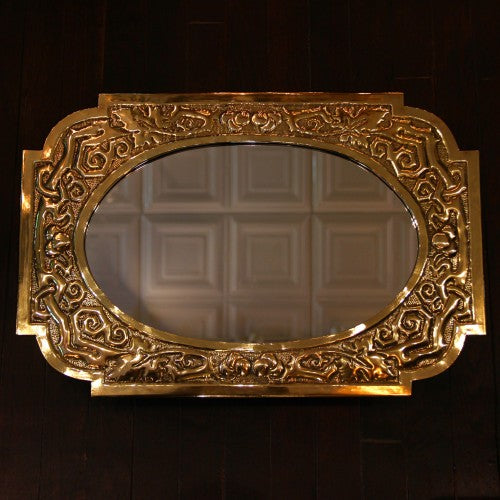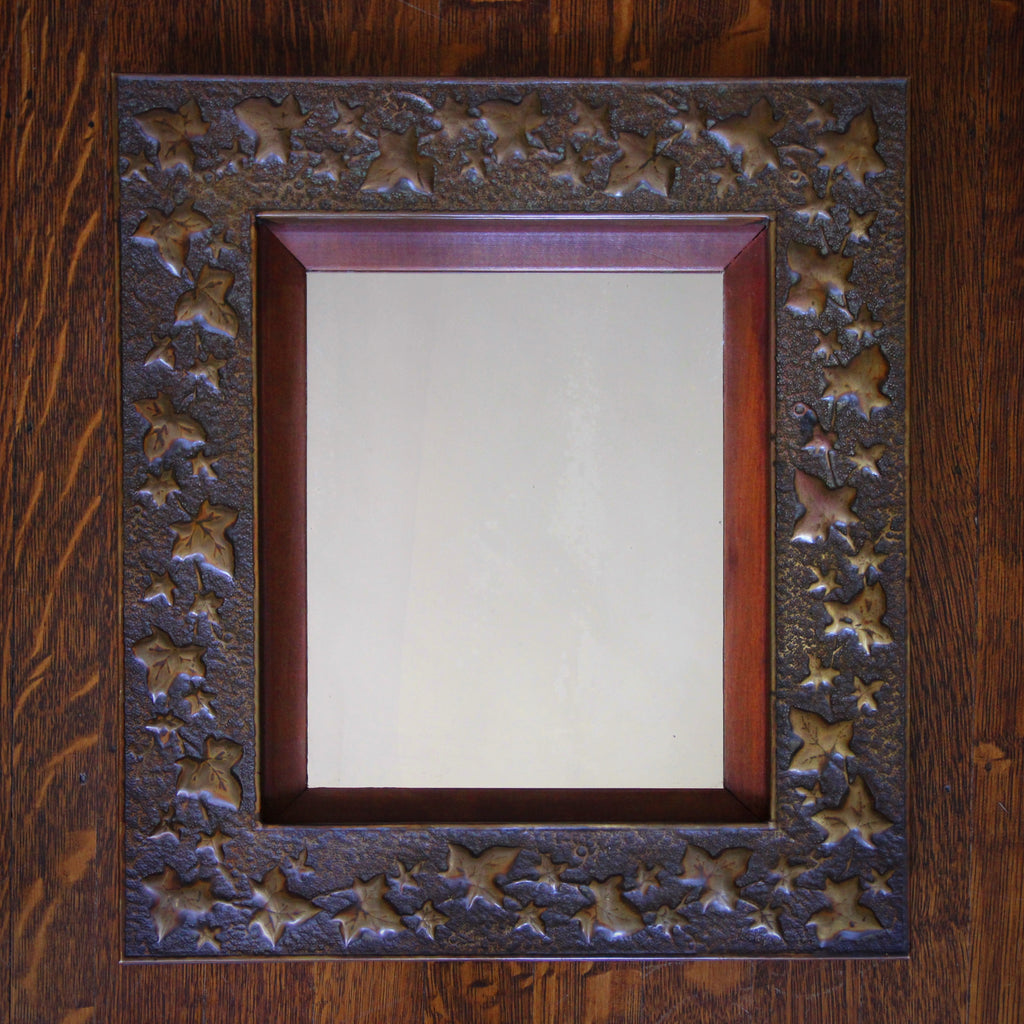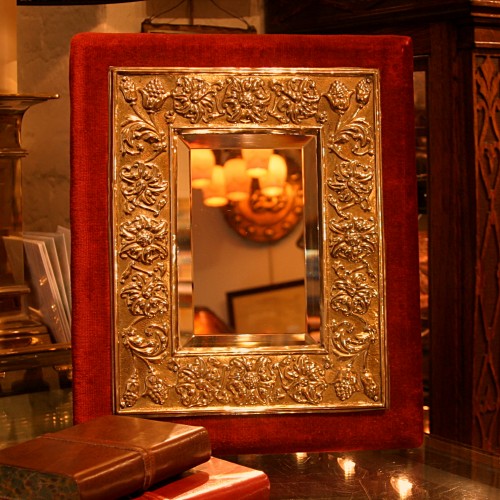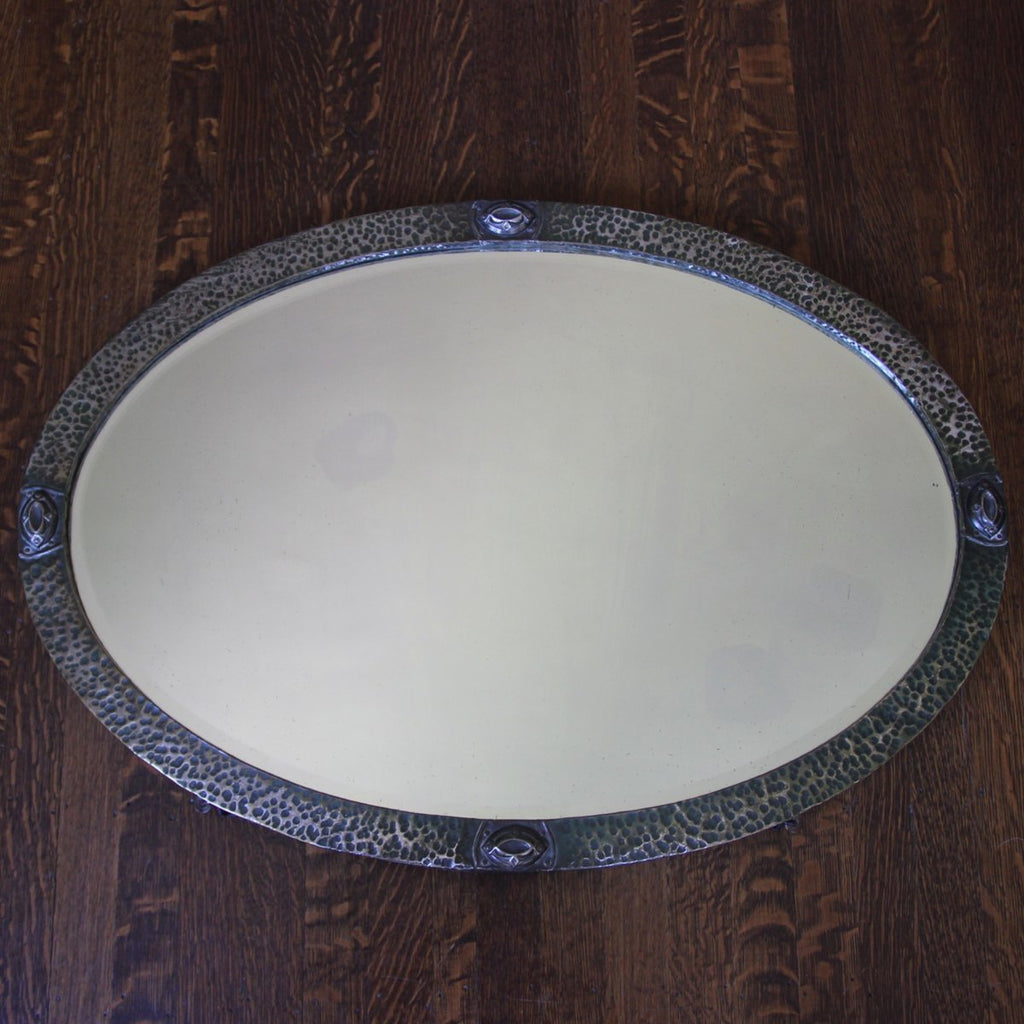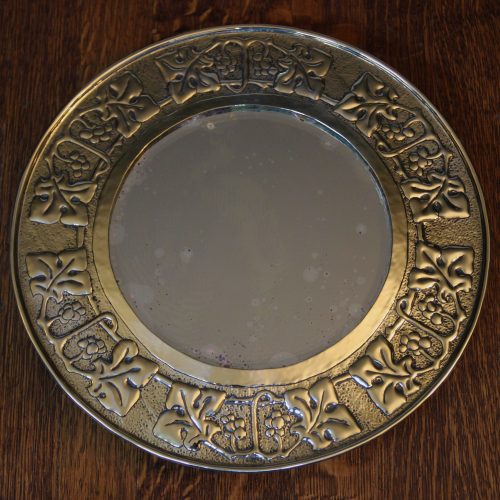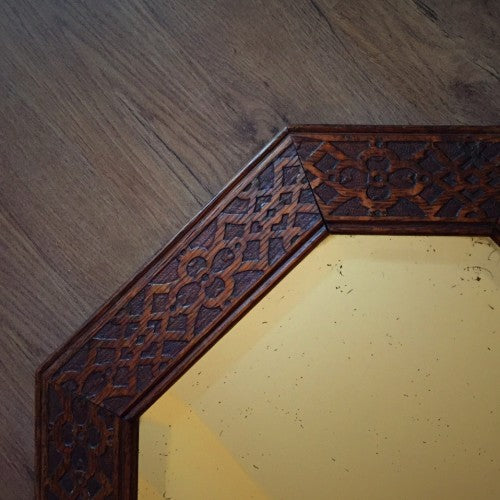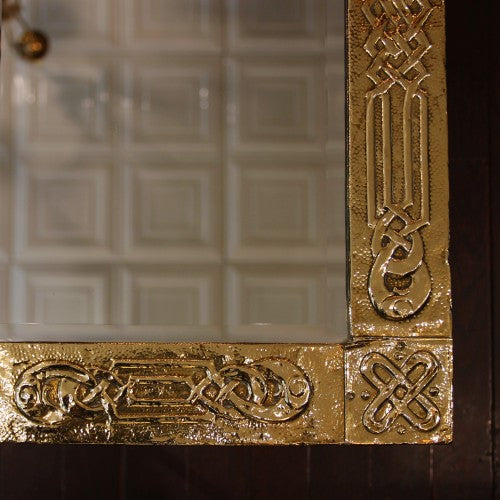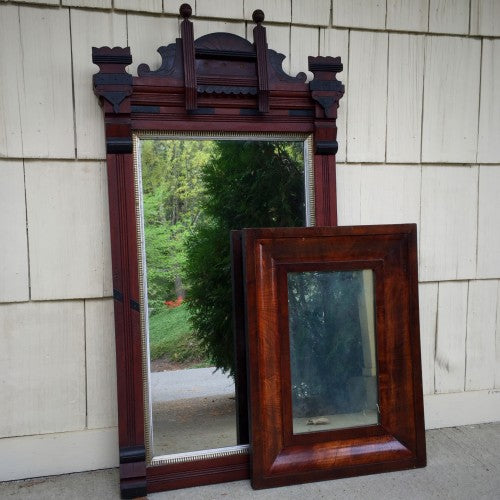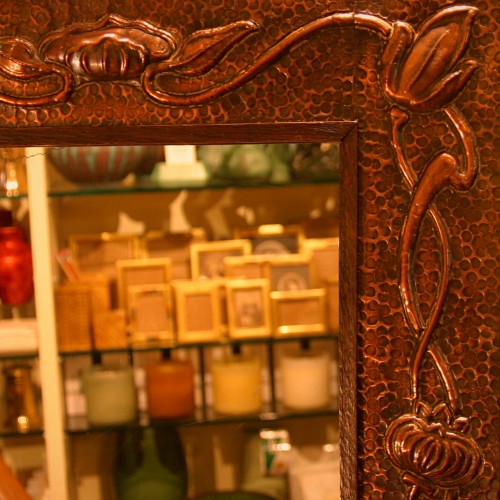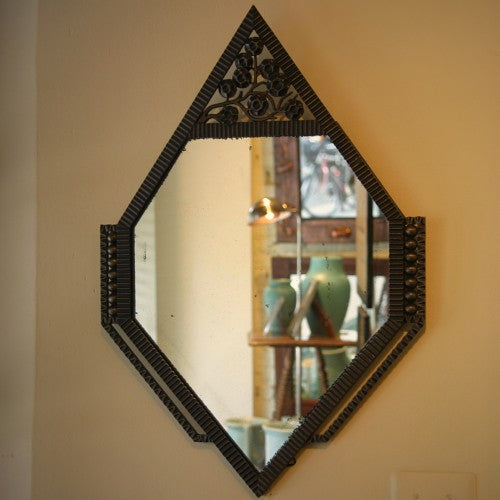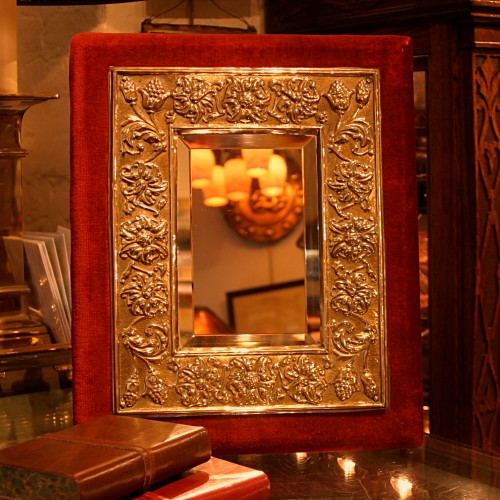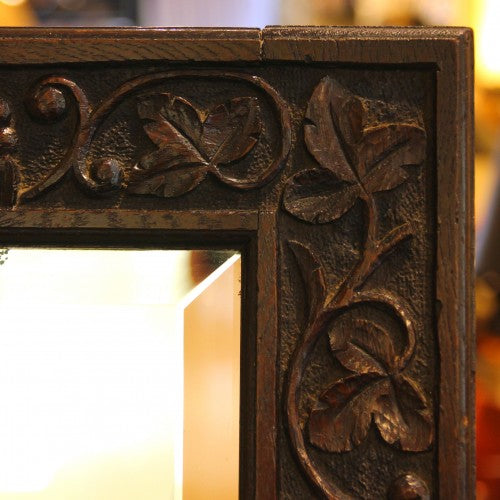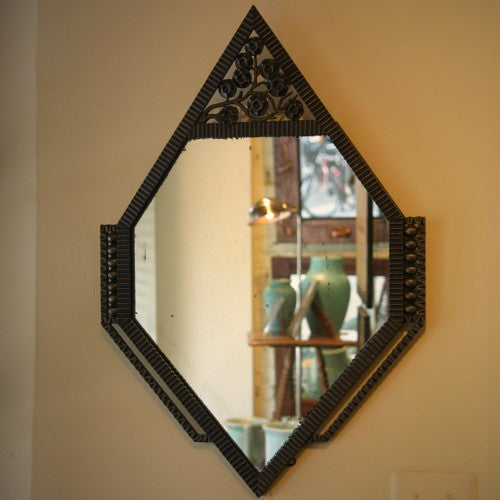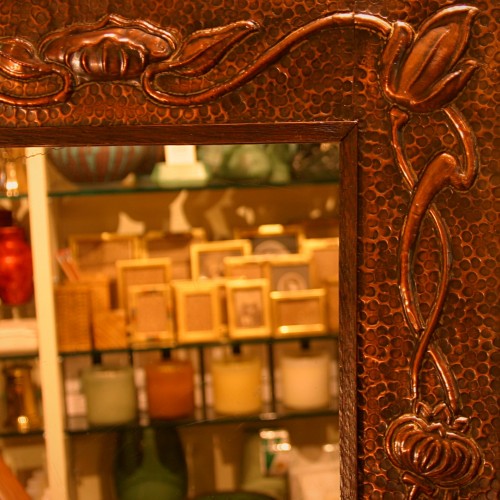JOURNAL — Mirrors RSS
This Scottish Arts & Crafts mirror is not large, but it packs a big punch. It was hand-crafted in Glasgow around the Turn-of-the-Century. The heavy brass frame is handsomely tooled with deep, scrolling "botanical whatnots"—like a wreath of intertwining rose stems. The crisp medallion-form frame, inspired by Adams (a Scotsman!), manages to confine the piece's sprawling, sculptural energy—which seems to want to burst-forth from the brass.
Arts & Crafts Mirrors - II
Different Arts & Crafts movements—in different parts of the world—sought to "travel back in time" by making references to their country's important historical, cultural, literary or aesthetic past. By reviving these ancient cultural elements, in an aesthetic manner, the Arts & Crafts movement was distancing itself from the Industrial present (and the social problems that came with modern life). Arts & Crafts movements endeavored to resurrect a feeling of the past—"a better, purer time" long, long before. In Scotland (and Wales and Ireland), Celtic motifs were a popular Arts & Crafts aesthetic theme. These "ancient and unspoiled" Celtic decorative elements ticked all the boxes: they were well-know yet primitive; they lent themselves to sophisticated handcraft; and they provided a tasteful...
Arts & Crafts Mirrors - I
When it comes to Arts & Crafts decoration, mirrors are heavy hitters for making a big impact, very quickly. Hammer-in a nail, hang the mirror, and there you go: instant architectural interest. Even in modern, non Arts & Crafts interiors, a handful of period mirrors will give your space a terrific aesthetic upgrade. Best of all, you can move them around easily and take them with you when you move!
The English Arts & Crafts bevelled mirror, shown above, was made around the Turn-of-the-Century. It features hand-hammered butterflies surrounded by classic, Art Nouveau whiplashing. The brass sheeting was hand-tooled and then wrapped around a wooden frame, for support.
Mirror, Mirror
I vastly favor antique mirrors with old—preferably original—glass. Old glass is wavy, hazy, sometimes a bit spotted or otherwise degraded by time. It has the right character to convey the piece's age, which new glass just cannot do. How much aging is the right amount? Well, a light sprinkling of dots is nice; maybe a grey haze of time. But I've never seen glass which looked "too old." In my life, only the bathroom mirror needs to be ultra-clear. This is where I shave and perform other delicate functions (sometimes with sharp implements) and want to see precisely what I am doing. All other times, "soft focus" is just fine. The American Empire mirror, shown above, is a handsome specimen...
Mirror, Mirror
In the Edwardian Era, when indoor plumbing was still a novelty, men would shave on a washstand—in the bedroom—using a large pitcher of hot water and a large ceramic water basin. Sometimes the washstand had a built-in mirror. Often, the washstand was simply tiled with glazed ceramic squares—an measure to keep the furniture water-resistant. An Edwardian English walnut shaving stand like this would have stood atop a washstand (or dressing table or chest of drawers). The stepped, chevron-form stand is mounted with a brass gallery to help corral the various tubes, mugs and pots associated with shaving. A divot in the center front is a handy place to store one's cufflinks or spare razors. The oval mirror is nicely bevelled and the...
April Showers - Part Twelve
We have been sharing some of our florally-inspired items over the past several days in honor of the Spring. Enjoy the season—including the flowers which delightfully distinguish this most wonderful of seasons.
It's Spring all year 'round—with this Victorian English Arts & Crafts mirror. A small bevelled glass is framed with a broad brass frame—beautifully hand-hammered with ambitious floral repoussé work. The glass and brass are mounted to a red velvet-covered back. It's perfectly sized for a small powder room or next to the door—for a quick inspection before leaving the house.
Mirror, Mirror
What once might have been (a little?) flamboyant, is now made very handsome with 140 years of age. The stately oak frame is embellished with a "rusticated botanical" gilded trim and finished with a gilded chain-form fillet. When I found the frame, its mirror (or print or painting) was long gone. So I replaced the mirror—springing for a deluxe one inch bevel. Now assembled, it makes for a very attractive package. It is currently hanging vertically, though I would happily change the orientation for you—just ask.
Moorish Beauty
The term "Moorish" is neither precise nor very specific. Through history, it has been used (often by Westerners) to refer to the people, the culture and the art of North Africa and the Middle East—combining-as-one the broad spectrum of varied Muslim and Arab civilizations. As Muslims conquered and expanded into new territories, they brought with them their art and architecture, adapting it to suit (and blend with) the existing architecture of the subjugated lands. Even outside of the Islamic world, Moorish aesthetic culture has influenced greatly the design of Western aesthetics (for many centuries). In the Eighteenth and Nineteenth Centuries, European architects used Moorish design elements to add theatrical flair to their buildings—seeking a new, dramatic flavor which was not as commonly-used as the Gothic...
Mirror, Mirror
Have a last-minute check before your next Zoom call—with this heavy and handsome Gent's Faux Staghorn Bevelled Hand Mirror. A small silver chevron, as yet unengraved, adorns the back. It was made in the 1910's or 1920's and has just the right amount of visible age to the glass. Click on the photo above to learn more about it.
Mirror, Mirror
While cloistered, I've been doing a lot of Spring Cleaning. The full treatment. Removing every little object from every shelf, table and mantelpiece. Removing Venetian blinds for cleaning. And Windexing every mirror and glazed picture. It's exhausting but it does help me sleep well at night. This bevelled mirror, made in England in the 1910's, looks great without a frame. Click on the photo above to learn more about it. Though our Greenwich Village store is now permanently closed, LEO Design is still alive and well! Please visit our on-line store where we continue to sell Handsome Gifts (www.LEOdesignNYC.com). We also can be found in Pittsburgh's historic "Strip District" at Mahla & Co. Antiques (www.mahlaantiques.com) or in Canonsburg, Pennsylvania at The Antique Center of...
Spring Fresh - part VIII
In the Northeastern United States, we typically do not see many butterflies until the late Spring or early Summer. Depending on the species, during the early Spring, butterflies are getting ready to migrate in search of food, a place to breed and a spot to lay their eggs before dying. Most butterflies live short lives in the "winged" form; two weeks to twelve months is the short extent of the fleetingly beautiful butterfly. In symbology, however, butterflies are quite important in the Springtime. For Christians, who celebrate Easter in March or April, the butterfly is a symbol or rebirth or resurrection. After being sealed in a "tomb" of spun silk, the hibernating caterpillar emerges as a beautiful, winged creature—taking flight...
Saw it Through the Grapevine
Art Nouveau craftsmen—whether they be in England, Austria, Scotland, France or the United States (and whatever they called their local Arts & Crafts movement)—often "recycled" decorative elements from their cultural or national pasts. English artisans often tapped Medieval themes (from literature or heraldry), aesthetic motifs from their ancient past (including Norse or Celtic elements) or significant design styles from the past (though centuries old). And the hand-crafted nature of Arts & Crafts production leant itself to the rustic work methods of earlier times. The English Arts & Crafts frame, shown above, was made around the year 1900. Nevertheless, it has a style and design of something from the Tudor or Jacobean period, up to 400 years earlier. Even the manner...
A Reflection on the Jacobean
King James of England and Scotland inherited both of his thrones from women. He became James VI of Scotland, at 13 months of age, when his mother, Mary Queen of Scots, was forced to abdicate. Some 36 years later, when Queen Elizabeth of England died without an heir, James became the King of England and […]
Reflections of Glasgow
I love visiting Scotland. And I love most things Scots—especially the Scottish Arts & Crafts. Therefore, I’m thrilled to have acquired, from turn-of-the-century Glasgow, a handsome, hand-hammered, brass-framed “looking glass”—embellished with a rich border of stylized, scrolling, sinewy botanicals. The Scots are a hearty lot; life eeked-out on the rocky, windswept land is not for […]
Science and The Art Nouveau – Part Two
“The God-given natural forms of leaves and flowers must be more perfect and beautiful than any invention of man.” – Augustus Pugin (1812-1852) With great strides being made in the advancement of scientific knowledge, botany was much-studied and better-understood. Although the compound microscope was a Renaissance invention (thank Galileo), it was not until the 1830’s […]
Through the Looking Glass
On this day in 1832, Charles Lutwidge Dodgson was born. He studied and taught mathematics at Oxford, excelled in the new art form, photography, was an Anglican Deacon, and wrote poetry and books—under the pen name, Lewis Carroll. While teaching at Oxford, he befriended a new dean, Henry Liddell, his wife and children. The youngest […]
Alice's Glass ?
After Lewis Carroll wrote Alice in Wonderland (1865), he wrote a sequel: Through the Looking-Glass, and What Alice Found There. It was published in 1871—some 30 years before this mirror was crafted. Still I couldn't help thinking, when I found it in Oxford this summer, that some "first generation" reader of the Alice novels might have peered-into this glass. Now the mirror is stateside, ready to bring it's mystery (if not magic) to some American home. Click on the photo above to learn more about it. LEO Design's Greenwich Village store is now permanently closed. While we contemplate our next shop location, please visit our on-line store which continues to operate (www.LEOdesignNYC.com). Follow us on Instagram: "leodesignhandsomegifts" Follow us on Facebook: "LEO Design...
Practical Art
Fresh from England: a nice quality small, round, bevelled mirror with a hand-hammered brass repoussé frame. In the manner of the Keswick School of Industrial Arts or the Glaswegian (Scottish) aesthetic, this British Arts & Crafts mirror is surrounded with a scrolling, stylized grape vine motif—complete with clusters of fruit and leaves. Useful as a mirror, it […]
Butterflies are . . . 25% Off
Tomorrow I make my first truck-run to storage—in Pennsylvania where I’ll begin stashing unsold merchandise until I’ve reinvented. While I hope to sell as much as possible (during our closing sale), I also realize that I will need good stock to begin the new LEO Design venture—and I’m extra-partial to certain items like this English […]
Notes From the Road – part IX
I loved this oak-framed, bevelled mirror the minute I found it! After dragging it through Rush Hour London (on the Tube), I got it back to my hotel where (dang!) it wouldn’t fit into by suitcase. As a result, I had to drag two (huge) suitcases plus a 1920’s English mirror through Victoria Station and […]
New English Receipts – part VI
We’ve been sharing some of our newly-acquired items, just brought back from England. Everything is now checked-in, cleaned-up, priced and put-out on display. Please come into the shop to see these new and beautiful items. In the meantime, we’re sharing a few selected pieces here in our Journal. Shown above, a Scottish Arts & Crafts […]
The Eleventh Hour of the Eleventh Day of the Eleventh Month
On this day—four or five years ago—I found myself in a London Waitrose supermarket, late in the morning. At 11 o’clock, precisely, a very serious-sounding manager came over the loudspeaker, asking us shoppers to observe two minutes of silence. It was my first acquaintance with the rituals of Armistice Day—which commemorates the 1918 end of World […]
Ivy League
Yesterday’s journal entry about Harvard sets-up today’s entry quite nicely: a different kind of ivy. Shown above, an English Arts & Crafts mirror which we’ve just acquired. Its bevelled, oval glass is surrounded by a thick quarter-sawn oak frame which has been deeply-carved with a trailing ivy motif. Perfect over a dresser, in a powder […]
Greeting August
Let’s welcome August and celebrate one of the month’s birth flowers: The Poppy. Poppies are thought to have originated in the Western Mediterranean and have been cultivated by Western and Central Europeans from about 6,000 BC. Early on, people recognized the analgesic properties of the plant. Ancient Egyptian doctors had their patients chew a mouthful […]
Aesthetically Pleasing
Remind your Dad who’s King of his Castle with this handsome, late-19th Century American Aesthetic Movement mirror, recently-acquired. While not the most typical of Father Day gifts, it will certainly make a handsome—and useful—addition to your father’s abode. Come see it in-person or click on the photo above to learn more about it. More interesting […]
Notes From the Road – part III
I continue to travel through New England this week, in-search of “Handsome Gifts”—especially gifts for Father’s Day. I’ve assembled a collection of impressive mirrors, two of which are shown above. The front mirror, made during the 1840’s to 1860’s, is crafted of mahogany veneer over a curved “ogee” profile. The larger mirror, in back, is […]
. . . Of Them All ?
We end our little tour of antique mirrors with this handsome English Arts & Crafts offering. Copper is hammered with a meandering poppy decoration resulting in a mirror that is functional as well as artful. Poppies—wild flowers from which one can extract a narcotic sedative—are associated with rest or sleep. In some places, the poppy […]
. . . Who’s the Fairest . . .
From 1920’s France, an iron-framed Art Deco mirror. The mirror has a crisp, machine-inspired angularity, with just a little spray of flowers at the top—a small nod to the previous Art Nouveau or Secessionist schools. Imagine this over an Art Deco sideboard, laden with crystal decanters, awaiting Nick and Nora Charles! Please come by the […]
. . . On the Wall . . .
Like yesterday’s mirror, this one also was made in Victorian England. It “reflects” a more-formal, more-refined English Arts & Crafts aesthetic. The brass surround is hand-hammered with a lush floral repoussé treatment—the result of hours of a craftsman’s labor. Perfect for a powder room, in a dining room, or beside the front door (for a […]
Mirror, Mirror . . .
What a dreary winter we’ve had! It makes sense that cooped-up New Yorkers would seek to bring more light into their apartments. For this reason, we sell a lot of lighting fixtures and mirrors—which produce and reflect light—during the Winter and early Spring. Shown above, a hand-carved oak-framed bevelled mirror, crafted in Victorian England. Made […]
Enter, Art Deco
By the mid 1920’s, with the horrors of The War in the past, the world was ready for a new, fashionable “look.” Streamlined, modern, forward-looking, Art Deco was perfectly-suited to industrial mass production. And it was very popular. Everything from skyscrapers to toasters to automobiles were designed in the new, “machine age” fashion. Whereas Arts & Crafts […]
Arts & Crafts, at the End
Yesterday we discussed the origins of the Arts & Crafts movement which flourished—in several countries, under different names—during the late Nineteenth and early Twentieth Centuries. As pointed out, this period coincided with the rise (in some countries) of a new middle class who now, perhaps for the first time, had disposable income to spend on […]


